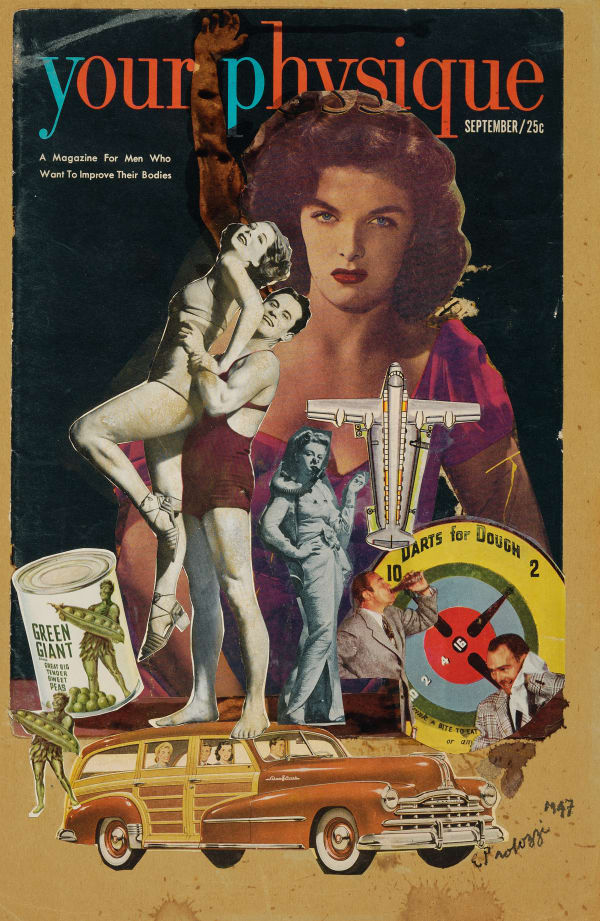Eduardo Paolozzi: Hollow Gods: Sculpture and Collage 1946-1960
Announcing its representation of Eduardo Paolozzi’s (1924 - 2005) estate, Hazlitt Holland-Hibbert is proud to host Eduardo Paolozzi: Hollow Gods (17 October – 13 December 2019), an exhibition focusing on the sculptures, collages and drawings that Paolozzi made in the first 15 years of his career. In collaboration with the Paolozzi Foundation, the exhibition is curated by Dr Judith Collins - a former senior curator at Tate, and author of the most recent monograph on the artist and of the forthcoming catalogue raisonné of his sculptures. The exhibition marks the first in a chronological series of Paolozzi shows that Dr Judith Collins will curate at the gallery in the coming years.
The exhibition includes 18 sculptures, three plaster reliefs and 15 works on paper, among them major works that have not been exhibited for decades, including the magisterial St Sebastian IV, and three large plaster reliefs from 1954-55 - once owned by Gabrielle Keiller, Paolozzi’s main patron in the 1950s.
Long before he was recognised as a founding father of Pop Art, Paolozzi was hailed as one of the brightest talents of the post-war generation. Awarded a solo exhibition at the Mayor Gallery while still a student in 1947, the renowned critic David Sylvester recognised Paolozzi as ‘the most positive and original’ sculptor in Britain. European by inclination and background, Paolozzi lived in Paris in the late 1940s where he associated with Giacometti, Dubuffet, Brancusi and Leger, before returning to London, where he lived for most of the 1950s.
It was under the post-war climate of survival that Paolozzi developed his vision of modern man as a lumbering, battered being. Ramshackle and improvised, his bronzes of the 1950s were the antithesis of polish, finish and idealism. Art historian Herbert Read described them as ‘blind encrusted larvae, formless in mass, logs that seem to have drifted from the primordial id,’ whilst his peer Robert Melville suggested they had been made in ‘the atmosphere of the street accident and the brutal hold-up’.
Often titled after biblical or mythological figures, Paolozzi said of his sculptures that he was not interested in the specific stories of saints or gods so much as the ‘irony of man and hero – the hollow god’. That sentiment resonated in an age when the creative powers of mankind had led to astonishing inventions and discoveries, and when at the same time some of the more comforting ideas about human nature had been severely tested.
In the exhibition catalogue, Dr Judith Collins returns to the writings of the critics in the 1940s and 1950s. Many of the extracts have not been published since then, and all of them reveal an appreciation of the unsentimental humanity of Paolozzi’s work during these 15 years.
James Holland-Hibbert, Director, Hazlitt Holland-Hibbert, says:
‘I am proud to announce that Hazlitt Holland-Hibbert will be representing the estate of Eduardo Paolozzi following a long-standing relationship between the gallery and the Paolozzi Foundation. In the past the gallery has championed Paolozzi’s pioneering early work and in the coming years we hope to continue to contribute to existing scholarship through a series of exhibitions spanning his career’
-
 Your Physique, 1952Collage
Your Physique, 1952Collage
14 x 9 inches; 35.6 x 22.9 cm
-
 Paris Bird, 1948-49Bronze13 3⁄4 x 14 x 6 1⁄4 inches; 34.9 x 35.5 x 15.8 cm
Paris Bird, 1948-49Bronze13 3⁄4 x 14 x 6 1⁄4 inches; 34.9 x 35.5 x 15.8 cm -
 Discobolus of the Castel Porziano, 1946Collage, ink and wash on paper8 ½ x 6 inches; 21.5 x 15.2 cm
Discobolus of the Castel Porziano, 1946Collage, ink and wash on paper8 ½ x 6 inches; 21.5 x 15.2 cm -
 Figure with Raised Arm, 1955BronzeHeight: 16 inches; 46 cm
Figure with Raised Arm, 1955BronzeHeight: 16 inches; 46 cm
Unique -
 Damaged Warrior, 1956BronzeHeight: 10 inches; 20.5 cmEdition no. 5/6
Damaged Warrior, 1956BronzeHeight: 10 inches; 20.5 cmEdition no. 5/6
Signed and stamped with foundry mark -
 Figure, 1956BronzeHeight: 25 inches; 63.5 cm
Figure, 1956BronzeHeight: 25 inches; 63.5 cm
Unique








